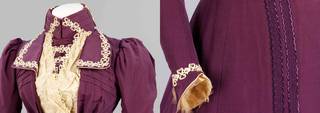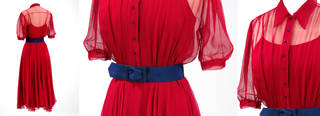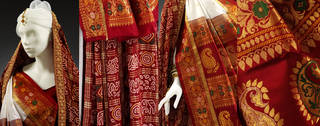Throughout history, brides have worn dresses that eschew the customary Western ideal of the white gown and veil. Whether due to quirks of economics, circumstances, cultural influences or a desire to 'go against the grain', the colourful wedding dresses in our collection make bold statements about the lives and attitudes of the different women who wore them.
Before 1840, when Queen Victoria wore an influential white dress for her wedding ceremony, it was quite usual for a bride to wear red, pink, blue, brown, or even black, while saying her vows. Despite growing interest in the royal white ideal, many women, particularly those with less money, continued to choose coloured or patterned fabrics in the mid-19th century, as they were more practical and affordable than white. Sarah Maria Wright wore a block-printed patterned dress for her wedding to Daniel Neal, an agricultural labourer, in Skirbeck in 1841. The pattern of Sarah's dress is up-to-date but the cut follows the silhouette of the mid to late 1830s, reflecting the slower pace of changing fashion in rural communities.


Due partly to economic progress and the rise of the middle classes, by the late 1800s, the white wedding gown became the expected choice for most brides. Even so, in 1889, lady's maid Harriett Joyce wore a crisply tailored purple dress for her marriage to Percy Raven Sams at Earlsfield, Middlesex. Aged 35, Harriet simply considered herself too old for a traditional white gown. A skilled sewer, she made the dress herself.


Forty years later, in 1938, Monica Maurice chose a striking red silk gauze wedding dress. Monica worked as an electrical engineer with the Wolf Safety Lamp Company. In 1938, as well as getting married, she became the first – and, until 1978, the only – female member of the Association of Mining Electrical Engineers. She travelled to Germany regularly in the 1930s and ran the Wolf Safety Lamp Company from 1951 to 1979, alongside raising three children. Monica went on to receive an OBE in 1975.


A vibrant, independent bride, on the cusp of changing marital roles, her choice of a brilliant-red, calf-length shirt dress with blue belt and buttons was both in-keeping with the emerging spirit of freedom, and a quirky demonstration of her own taste and character.
In cultures around the world, colour has always been favoured. In India, red is a popular choice, as it is thought to signal future success and prosperity. The fine red wedding saris, donated by Anjali Bulley, (nee Raval), are a vivid example.


On 31 October 1998, Anjali married Paul Bulley in a Hindu ceremony in north-west London. The celebrations took place over three days, with the wedding on the third day. Anjali wore a red, white and gold panetar sari, given to her by her parents, and a red and gold gharchola sari given to her by her new in-laws. Both saris were purchased in Gujarat and arranged in the traditional manner. The gharchola sari is beautifully decorated with tie-dyed elephants and peacocks, which are symbols of good luck. The custom of wearing two saris together allows both sets of parents to symbolically invest in the new marriage.
Another vibrant example, combining East and West influences, as well as vivid colour, is this hand-painted coat designed by Richard Cawley, for London fashion house Bellville Sassoon. It was presented as part of the 1970 Winter Couture collection, inspired by Indian art and culture.


The coat featured in the November 1970 issue of Vogue magazine. It was then worn by Sara Donaldson-Hudson for her registry-office wedding to Nicholas Haydon on 23 April 1971. Sara's mother, Dorothy, was a dedicated follower of fashion who did not want her daughter to wear white to marry a divorcé. Between them, they chose this colourful coat, which was worn over a bright orange shift dress and orange satin knee boots, which matched the coat lining.

